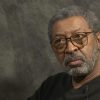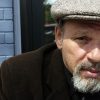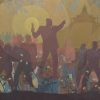
Police in riot gear march towards protestors, who were demanding justice for Michael Brown, near the Edward Jones Dome, the site of an NFL football game between the St. Louis Rams and the Oakland Raiders, in downtown St. Louis, Missouri November 30, 2014. (Adrees Latif/Reuters)
Michael Brown’s death was part of a tragic and unacceptable pattern: Police officers in the United States shoot and kill civilians in shockingly high numbers. How many killings are there each year? No one can say for sure, because police departments don’t want us to know.
According to the FBI’s Uniform Crime Report, in 2013 there were 461 “justifiable homicides” by police — defined as “the killing of a felon by a law enforcement officer in the line of duty.” In all but three of these reported killings, officers used firearms.
The true number of fatal police shootings is surely much higher, however, because many law enforcement agencies do not report to the FBI database. Attempts by journalists to compile more complete data by collating local news reports have resulted in estimates as high as 1,000 police killings a year. There is no way to know how many victims, like Brown, were unarmed.
By contrast, there were no fatal police shootings in Great Britain last year. Not one. In Germany, there have been eight police killings over the past two years. In Canada — a country with its own frontier ethos and no great aversion to firearms — police shootings average about a dozen a year.
Liberals and conservatives alike should be outraged at the frequency with which police in this country use deadly force. There is no greater power that we entrust to the state than the license to take life. To put it mildly, misuse of this power is at odds with any notion of limited government.
I realize that the great majority of police officers never fire their weapons in the line of duty. Most cops perform capably and honorably in a stressful, dangerous job; 27 were killed in 2013, according to the FBI. Easy availability of guns means that U.S. police officers — unlike their counterparts in Britain, Japan or other countries where there is appropriate gun control — must keep in mind the possibility that almost any suspect might be packing heat.
But any way you look at it, something is wrong. Perhaps the training given officers is inadequate. Perhaps the procedures they follow are wrong. Perhaps an “us vs. them” mentality estranges some police departments from the communities they are sworn to protect.
Whatever the reason, it is hard to escape the conclusion that police in this country are much too quick to shoot. We’ve seen the heartbreaking results most recently in the fatal shooting of 28-year-old Akai Gurley, an unarmed man who was suspected of no crime, in the stairwell of a Brooklyn housing project, and the killing of 12-year-old Tamir Rice, who was waving a toy gun around a park in Cleveland.
Which brings me to the issue of race. USA Today analyzed the FBI’s “justifiable homicide” statistics over several years and found that, of roughly 400 reported police killings annually, an average of 96 involved a white police officer killing a black person.
Two years ago, D. Brian Burghart, the editor and publisher of the Reno (Nev.) News & Review, launched FatalEncounters.org, an ambitious attempt to compile a comprehensive crowd-sourced database of fatal police shootings. Reports of the October 2012 killing of a naked, unarmed college student by University of South Alabama police made Burghart wonder how many such shootings there were; the fact that no one knew the answer made him determined to find it.
Burghart recently summed up what he has learned so far: “You know who dies in the most population-dense areas? Black men,” he wrote on Gawker. “You know who dies in the least population-dense areas? Mentally ill men. It’s not to say there aren’t dangerous and desperate criminals killed across the line. But African-Americans and the mentally ill people make up a huge percentage of people killed by police.”
Burghart and others who have attempted to count and analyze police shootings shouldn’t have to do the FBI’s job. All law enforcement agencies should be required to report all uses of deadly force to the bureau, using a standardized format that allows comparisons and analysis. Police departments that have nothing to hide should be eager to cooperate.
The Obama administration has been laudably aggressive in pressing cities with egregiously high rates of police shootings, such as Albuquerque, to reform. But no one can really get a handle on the problem until we know its true scope.
The Michael Brown case presents issues that go beyond race. An unarmed teenager was shot to death. Whatever his color, that’s just not right.














